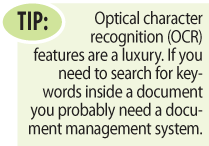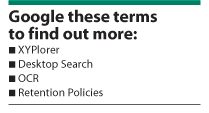Subscriber Benefit
As a subscriber you can listen to articles at work, in the car, or while you work out. Subscribe Now
 You promised your-self this would be the year you went “paperless.” The year is half over. How’s that working out for you?
You promised your-self this would be the year you went “paperless.” The year is half over. How’s that working out for you?
Paper has some wonderful advantages: It’s cheap, portable and sturdy. What’s not to love? It’s also bulky, non-searchable and difficult to share. Many strategies that aim to reduce your dependence on paper trade “familiar and simple” for “complex and powerful.” When you add “costly” to “going paperless,” many plans get derailed.
Going paperless is not document management
For the firm that is just starting down the paperless path, adopting a full-on document management system can be daunting. DM includes systems that manage workflow, routing, permissions, retention policies and indexing. Typical programs cost thousands of dollars and may take days away from work for training. They can be the information backbone of a large firm or simply back-breaking for the solo with a small staff.
Our experience is that going paperless doesn’t have to be painful. Here are some practical tips to propel your paperless plans into unparalleled productivity.

1. Refine your current computer filing system
Most firms have a decent computer filing system – but going paperless means adding a lot more files. Create template folder structures with place-holders for folder names and simply copy and paste those structures to kick-start new clients or matters. This method is efficient and guarantees consistency.
Create naming rules that make it easy to search for a file. A simple scheme that includes the type of document, version, party, etc. is best. Don’t be terse – names of files and folders can be two dozen characters or more.
You’ll find some great examples in this American Bar Association article from “Law Practice Today.” http://bit.ly/FolderTemplate
2. Stop the paper before it multiplies and spreads
Identify choke points where paper enters your business, and create procedures to eliminate it as quickly as possible. Scan documents when and where you open the mail on a fast, two-sided (duplex) scanner that sits on your desk. Good ones cost about $500. The Fujitsu Scan Snap S1500 includes Adobe Acrobat Standard.
Communicate your paperless preference to business partners, vendors and colleagues. You may find they have great ideas you can use.

Subscribe to a service – or buy a system – that converts incoming faxes to PDFs and delivers them via email attachments. Then detach the PDFs and store them in the appropriate place.
3. Think data safety
The compliment to a good scanner is a great shredder! But that takes courage unless you have a reliable backup system. I recommend a dedicated file server, daily local and offsite backups and regular monitoring by a competent professional. Digital backup and disaster recovery systems are as much a part of a paperless office as a scanner.
As a backstop, you should keep documents organized chronologically for at least the time it takes to be sure their scanned versions have been protected by backups.
4. What do you do after you’ve scanned a document?
When you eliminate paper you’ve also lost a key part of most traditional workflow systems. Many firms depend on paper moving from desk to desk to trigger processes like docketing, follow-ups and analysis.
I recommend you train the person scanning the document to take these three steps after the document is scanned. I call it the 3 Ps:
Put – Put the scanned image in the right place.
Pass – Pass the file (or a link to it or note about it) to someone who needs it or who will decide what needs to be done next.

Post – Post a record in a docketing system, calendar, bookkeeping database or action list.
5. What to do with the paper you already have
You may be tempted to start your paperless project by scanning your archives’ files. I suggest you wait until after you have refined your system and know more about how you really want it to work.
There are service bureaus that specialize in high-speed scanning you can employ to get rid of really large piles of paper. Alternatively, you can hire temps or conscript your kids to help.
The key is to make sure the files get named accurately and stored properly.•
__________
Kim Brand is a technology expert, author and president of Computer Experts, Inc. In addition to the Indiana Lawyer, he writes for West Publishing, the ILTA and the IL Bar Association. Kim also contributed to the ‘On-Premises’ section of the recently released ILTSO.org legal technical standards and he is the inventor of the FileSafe Server used by many law firms. The opinions expressed are those of the author.
Please enable JavaScript to view this content.
